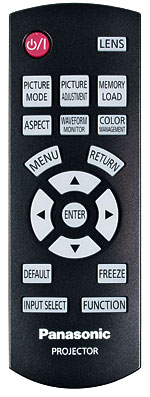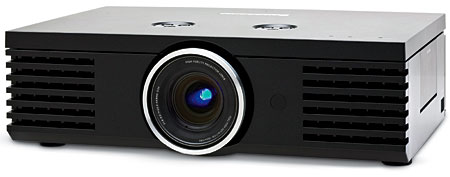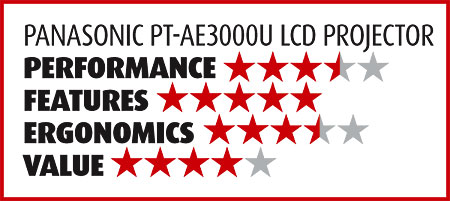Panasonic PT-AE3000U LCD Projector Page 2
The Advanced menu offers the kind of tweaks you’d normally find in a hidden service menu. It includes full gray-scale and color-tracking adjustments, gamma correction, and color management. You’ll also find Panasonic’s noise-reduction filters, video-processing options, and frame-creation modes here. I’ll touch on those a bit later.
 Panasonic includes seven different picture modes, and you can use any of them as a starting point for your setup. I was most interested in the Color 1 and Cinema 1 selections. Color 1 provides a reasonably accurate viewing mode for HDTV signals. It includes a more reasonable color gamut in relation to the standard Rec. 709 color gamut and a nearly dead-on gray scale. Cinema 1 uses a filter that boosts the color gamut a bit more, which gives colors a little more pop. Panasonic says it created this mode with the help of Hollywood colorists to provide a more cinematic experience. The gray scale in this mode was nearly dead on, but the colors were a bit oversaturated.
Panasonic includes seven different picture modes, and you can use any of them as a starting point for your setup. I was most interested in the Color 1 and Cinema 1 selections. Color 1 provides a reasonably accurate viewing mode for HDTV signals. It includes a more reasonable color gamut in relation to the standard Rec. 709 color gamut and a nearly dead-on gray scale. Cinema 1 uses a filter that boosts the color gamut a bit more, which gives colors a little more pop. Panasonic says it created this mode with the help of Hollywood colorists to provide a more cinematic experience. The gray scale in this mode was nearly dead on, but the colors were a bit oversaturated.
Panasonic’s color-management system is a little bizarre compared with CMS systems I’ve used in the past. You use a cursor to pick the color you want to adjust on the screen, and from there, you can adjust saturation, hue, and brightness. The only problem is that the affected color doesn’t change the other colors in relation to it. So it’s hard to see what effect the adjustment has on all the points, from the color you choose all the way to white. When I used this system with our precision test instruments, I got the color points nearly dead on for Rec. 709. However, the color balance seemed a bit off with normal viewing. If you don’t have professional-grade instruments, I’d suggest that you engage the Color 1 mode for an accurate color gamut without any noticeable side effects.
Calibration was a snap when I used the video modes I discussed earlier. Gray scale was already quite good, and I dialed it in to perfection with the Adjustment menu. Color tracking over the brightness range was dead on. The PT-AE3000U did have one anomaly, though. While some above-white material passes, clipping starts near the digital 245 mark. Normally, above-white signals extend from digital 236 all the way to digital 255, but regardless of the setup mode I used, this projector clipped in the mid-240s. You might argue that there is rarely material beyond this value in the video signal, but purists who prefer to keep the entire dynamic range intact should take note. The Panasonic retained below-black values, which made brightness calibration a snap.
The PT-AE3000U’s remote was the most disappointing of the bunch. I liked its small form and easy layout, but the projector only responded to it with a perfect line of sight. As I navigated the projector’s extensive menus, I became more and more frustrated. The remote is backlit, which is always a plus. It also has quick keys to most of the setup features, along with picture modes and lens adjustments.
Video Processing
Panasonic uses its own solution for SD and HD video processing. The projector did a great job with SD video processing, and it passed our tests with film-based 1080i sources. This means that movies at 1080i will play back artifact-free. It didn’t do as well with video-based sources at 1080i. You’ll need to consider adding superior video processing in your AVR or surround processor to make the most of concert videos and some broadcast HD signals. With 1080p signals, the projector did a great job and resolved the full resolution with no signs of ringing or rolloff.

Panasonic is the only manufacturer in this group that includes a frame-creation option. If you’ve looked at flat-panel displays lately, you’ve noticed that the big craze is 120-hertz refresh rates. A 120-Hz display normally shows a single frame multiple times or uses other video processing. Panasonic gives you two options with its frame-creation option. Mode 1 interpolates one single frame between each frame, and Mode 2 interpolates three frames. This isn’t frame doubling or tripling; it literally creates a completely new frame (or three).
This process has several effects on the video image. Since you’re creating new frames, pans have more detail and will appear smoother. This gives film images a smoother look, with motion that you may or may not like. I liken the look to daytime soap operas. It replaces the judder of 24-fps material with a much smoother (although, in my opinion, unnatural) look. I turned it off after I tested it with several different clips.
In Use
Without a doubt, Panasonic brings the kitchen sink when it comes to features. Still, nothing is more important than the image when all is said and done. The PT-AE3000U throws a great image for a low-priced LCD, but it comes up a little short compared with the other contenders in this roundup. The Panasonic was a tad sharper than the Sony, despite having a pixel smoother, but it was the weakest in terms of contrast. The image still had good depth and detail, but even with the dynamic iris, black levels fell short of what the Sony and Mitsubishi offer. Shadow detail was good, but absolute blacks were more typical of LCD-based projectors and looked like a very dark gray. I also saw some dynamic range compression with white levels when there was a lot of black on the screen. I attribute this artifact to the performance of the dynamic iris system.
The Panasonic had no issues with banding, and I was really impressed by its natural balance of colors. With brighter material, the PT-AE3000U looked outstanding and had great detail and natural dimension. Fleshtones looked very natural, and even with the Cinema1 mode’s stronger color palette, colors still had a nice pop and balance. It’s amazing that you can get an image this good for less than $4,000. In terms of performance, this projector surpasses some flagship designs from only a couple of years ago.
Conclusion
The PT-AE3000U is an amazing value and a tweaker’s delight. Other than color, the image didn’t quite topple the more expensive Mitsubishi, but it held its own. If you’re looking for cutting-edge features and solid video performance, you should definitely give this one a spin.

- Log in or register to post comments






























































